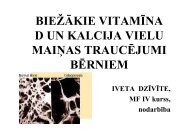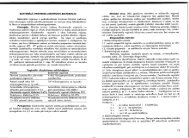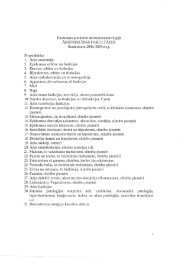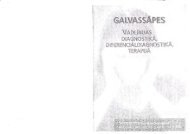PHYSICS
n - susliks.lv
n - susliks.lv
- No tags were found...
Create successful ePaper yourself
Turn your PDF publications into a flip-book with our unique Google optimized e-Paper software.
6.2.5. Stokes' Law<br />
When a sphere of radius R moves with velocity V through a<br />
stationary fluid and if the motion is nonturbulent, then the<br />
viscous drag (F) on the sphere is given by Stokes' law:<br />
F s=61r1]RV<br />
(6.12)<br />
where TJ is the viscosity of the fluid.<br />
6.2.6. Erythrocyte Sedimentation Rate<br />
The coefficient of viscosity (TJ) depends on temperature; the<br />
approximate viscosity-temperature relation is:<br />
b<br />
1]=a.eT (6.13)<br />
where a and b are constants and T is the absolute temperature.<br />
The erythrocyte sedimentation rate (ESR) measures the distance<br />
red blood cells will fall along the length of a vertical tube<br />
over a given time period (e.g., I hour).<br />
Sedimentation is normally accelerated as the temperature rises<br />
and the viscosity decreases [see equation (6.13)]:<br />
I<br />
V==- (6.14)<br />
1]<br />
Sedimentation of red cells depends on the forces resisting<br />
sedimentation (e.g. negative charges on the red cells surface, the<br />
opposite stream of plasma, rigidity of the red cells) and the<br />
forces accelerating sedimentation (e.g. anemia, plasma proteins).<br />
Changes ESR values are associated with changes in plasma<br />
proteins with can be caused with various diseases (e.g. rheumatoid<br />
arthritis, temporal arteritis, polymyalgia rheumatica, tuberculosis<br />
and Hodgkin's).<br />
6.2.7. PoiseuiIle's Law of Flow<br />
The French physicist Poiseuille showed experimentally that the<br />
volume (Q) of liquid flowing through a tube of length I is directly<br />
proportional to the pressure difference (p J - p) driving the liquid, and<br />
proportional to the fourth power of the tube radius (R). The laminar<br />
flow of liquids in pi pes is described by Poiseuille's Law 0/Flow:<br />
54<br />
I 1r·R 4<br />
Q =--;]'8T'(PI - pz)· (6.15)<br />
Poiseuille's law of flow can be used to quantitative measure<br />
the viscosity (TJ) of liquids.<br />
6.2.8. Sedimentation<br />
When a sphere falls in a viscous medium, it reaches a terminal<br />
velocity when the retarding forces, viscosity (F, = 6·1r·TJ·R· V) and<br />
buoyancy (FA =pm-V· g =~ .n.R 3 p m·g) equal the weight (m- g =<br />
=~ .n.R 3 p s p<br />
• g) of the sphere:<br />
f.n . R 3 • Psp • g = ~ . tt . R 3 • Pm' g + 6 . n . 1] . R . V (6.16)<br />
where m is the mass of sphere, R = ~ -<br />
the radius of sphere, P sp<br />
and Pm - the density of the sphere and medium, and TJ - the<br />
viscosity of the medium.<br />
2· g . R Z • t . (p - P )<br />
Hence. · 1] - Sp m (6 • 17)<br />
9·/<br />
and the terminal velocity (also called sedimentation velocity) can<br />
be determined as:<br />
V = g. P sp -<br />
Pm<br />
2. R Z<br />
1] 9<br />
6.2.9. Physical Principles of Ultracentrifugation<br />
(6.18)<br />
The movement of spherical particles in a centrifuge tube<br />
(fig. 6.8) eventually reach a terminal velocity determined<br />
by the frictional force (F; = 6·n·TJ·R· V), centripetal force<br />
mmV 2 2 V 2 )<br />
( Fcp = .---- = m 11/UJ r = Pm UJ r<br />
r<br />
55






